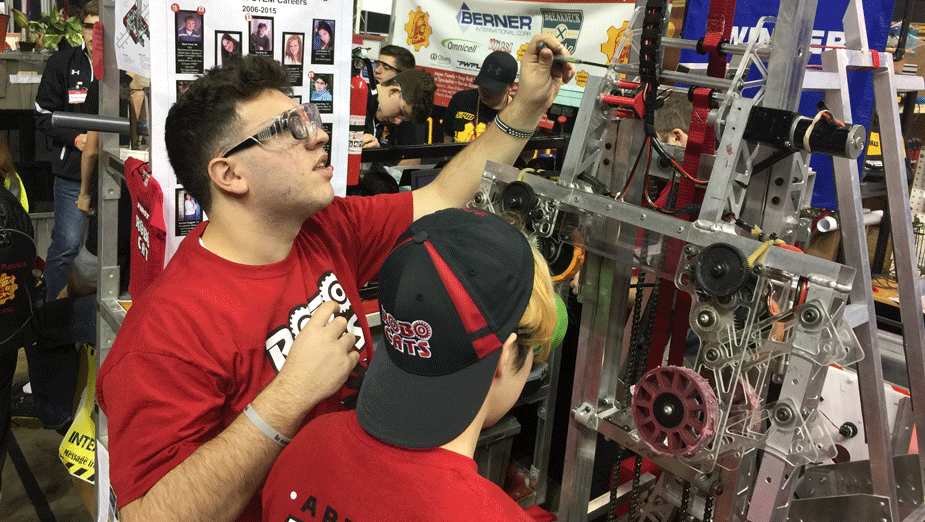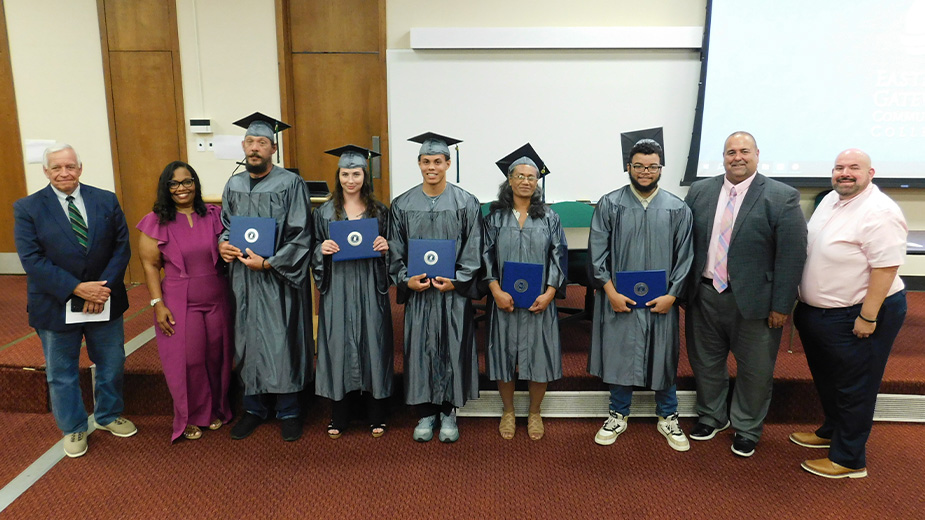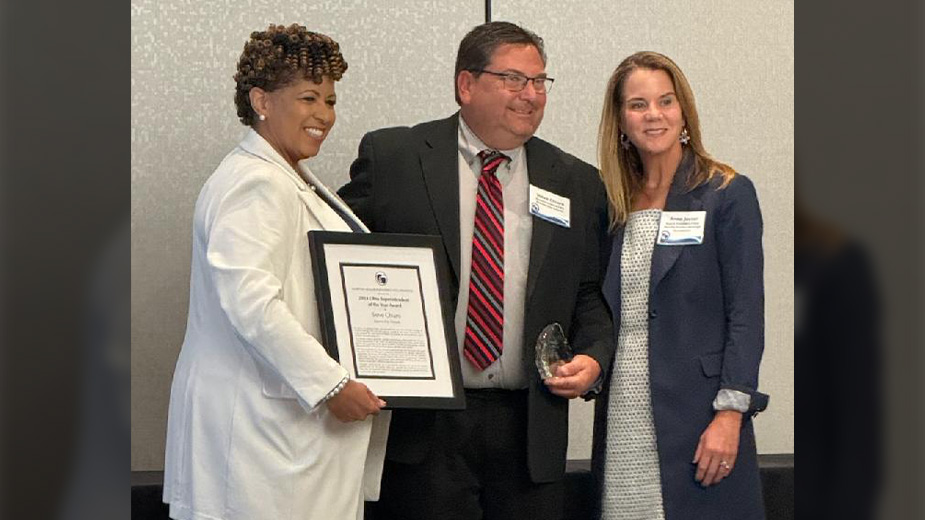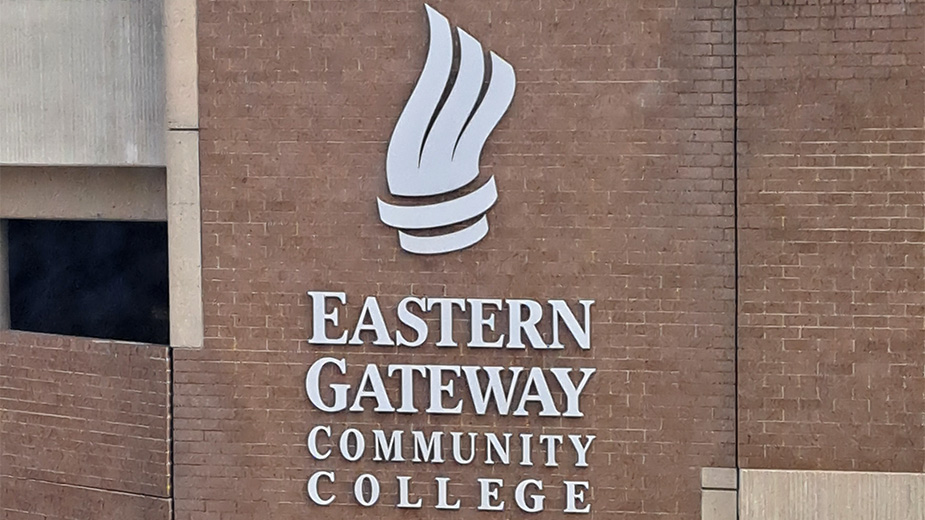Students Receive Firsthand Training on Robotics
GIRARD, Ohio — One year it might be an automaton programmed to launch Nerf balls. Another year it could be a cyborg tossing a Frisbee. Or, as exemplified just months ago, it could be a robot zipping about a competition floor, picking up crates and stacking them atop a large scale in a matter of minutes.
Such is the world of the First Robotics Competition – a seasonal initiative that encourages high school students all across the country to build and operate robots designed to perform a specific task. Ultimately, these robotics teams duke it out in regional and national competitions held each academic year.
Moreover, it allows students a peak as to what the future holds for automation and the role it plays in manufacturing.
“We never know what they’ll throw at us,” says Ashraf Hadi, the build team adviser and technology educator at Girard High School. First – an acronym for “For Inspiration and Recognition of Science and Technology” – was established in 1989 to boost interest among young people in science, technology, engineering and mathematics, or STEM, disciplines.
The Girard First robotics team – dubbed the RoboCats – has been active since 1999, Hadi says. As an afterschool club, participation in the program does not carry any credit toward graduation. However, the robotics program has made a lasting effect on the broader goal of the school toward developing a more STEM-focused curriculum.
“It’s really helped infuse and implement a curriculum geared around it,” Hadi says. “Before robotics, there was no real STEM program here.”
He credits much of the success to Girard City Schools Superintendent Joe Jeswald, who spearheaded the drive while a teacher at Girard High School. Today, Hadi teaches courses in 3-D printing and design, engineering principles and manufacturing and automation. “Next year, we’ll implement a drone class,” he says.
The Girard team is supported through corporate and community donations, both financial and in-kind contributions, Hadi says.
Each year, First robotics issues its participating members a booklet explaining the rules for the upcoming season. Every team uses the same materials, so each robot competes on an even playing field. What differentiates each team is its robot design and program adaptability.
“After the kickoff, we have six weeks to brainstorm a design, create a prototype, and then build and program it,” Hadi says. Girard teams have become so efficient that members can build two identical robots during this period – one shipped for competition, the other used for testing and practice. “We can beat it up and find out its weaknesses and what problems arise during competition,” he says. “It opens up opportunities for a better design.”
On average, the Girard team competes in three events each academic year. Each robot is constructed on site, then programmed to complete the specific task. “There are usually 40 to 60 teams per competition,” Hadi says.
This year, the Girard team placed first in the Miami Valley Regional Competition in Dayton and qualified for a spot in the world championship held recently in Detroit. “Unfortunately, we [were] eliminated during the semifinal round,” he says.
Introducing robotics and automation to students at an early age is imperative to preparing a workforce likely to step into a world where business and manufacturing are directly guided by sophisticated technology.
According to the International Federation of Robotics, the population density of robots in the manufacturing sector is on the rise worldwide and domestically. On average, there are 74 robots for every 10,000 workers in the global manufacturing economy, up from 69 per 10,000 two years ago.
In the United States, the number of robots per employees in the manufacturing sector is on the increase. As of 2018, there are 189 installed industrial robots in operation for every 10,000 employees in manufacturing. In 2016, that number stood at 175 for every 10,000 workers.
“This is a field that has not been talked about enough and demand is coming a lot quicker than anyone expected it to,” observes Rachel Young, STEM coordinator at the Valley STEM+ME2 Academy, housed in the Mahoning County Career and Technical Center in Canfield.
The academy is open to high school freshmen and sophomores anywhere in Ohio, Young says, but draws mostly from Mahoning County because of its proximity to students in the region. Just short of 200 students are enrolled in the school, with about 80 in the robotics program.
“It was a sophomore elective this year, but now we’ve expanded it to include freshmen next year,” she reports.
Robotics courses are featured as student electives at Valley STEM, Young says, but the field is relative to other disciplines such as computer programming and other forms of automation and math.
Students experiment with Sphero droids – robots programmed to roll and perform various tasks through commands from a tablet or laptop, Young says. Valley STEM students are also engaged in Lego Robotics programs and some participate in an afterschool club, Vex Robotics.
The Vex program works much like the First program. Both are designed and developed to advance the skills and knowledge of robotics through practical experience and application.
Vex, in addition, offers students a Vex virtual worlds program where students can program and build a robot completely online.
“These students get to learn collaboration, group work, using an engineering notebook,” Young says, “and how to interact with other teams.”
Introducing robotics principles to students at an early age is fundamental to keeping them interested as they get older, notes Ric Zimmermann, a program adviser for the First Robotics program at Austintown Fitch. “We’re starting them as early as first grade,” he says.
Grades one through four are open to participating in the First Lego League Jr. program, which introduces children to concepts related to applying basic engineering principles. The early programs are noncompetitive. They become more challenging as the student gets older: The First Lego League is open to grades five through seven, the First Tech Challenge is open to eighth and ninth graders, while the First Robotics Competition accepts all high school students.
“The last two years, we’ve had about 100 kids from grades one through 12,” Zimmermann says, while the robotics program averages 22 students per year. And, students continue to show interest throughout the summer since the First club continues to meet during vacation. “Last summer, we built a six-barrel, self-propelled T-shirt cannon,” he says.
This exposure to robotics and its applications has inspired many graduates to move into fields such as computer engineering as it relates to manufacturing and other sectors of the economy, Zimmermann says.
“We had a graduate two years ago who is looking to get into physical therapy,” he says. “She wants to see how the use of robotics will impact movement of artificial limbs. Another graduated from the University of Akron and is in cellular engineering for one of the rubber companies there.”
Pictured at top: Girard RoboCats Shane Biddle and Avery Tinkey work on a robot at a contest in Cleveland.
Copyright 2024 The Business Journal, Youngstown, Ohio.



